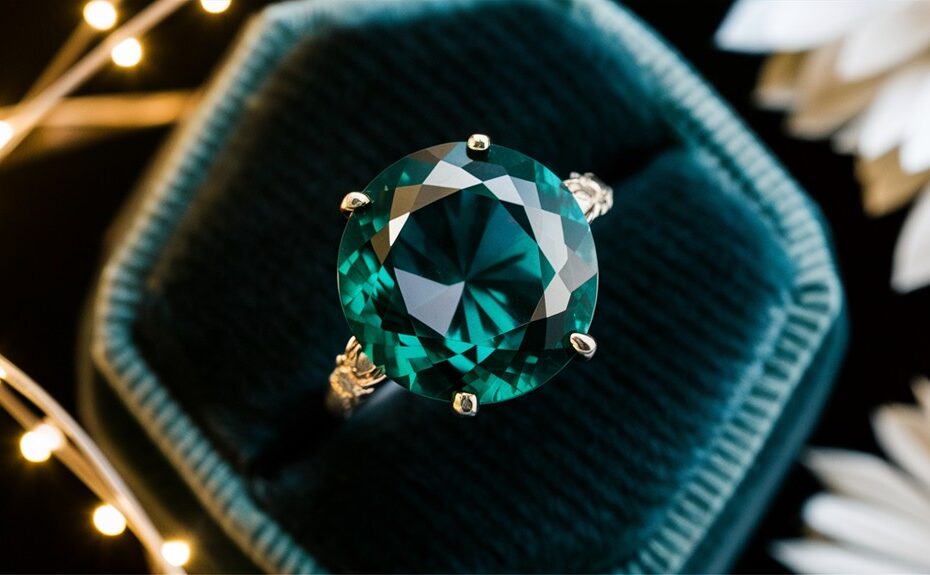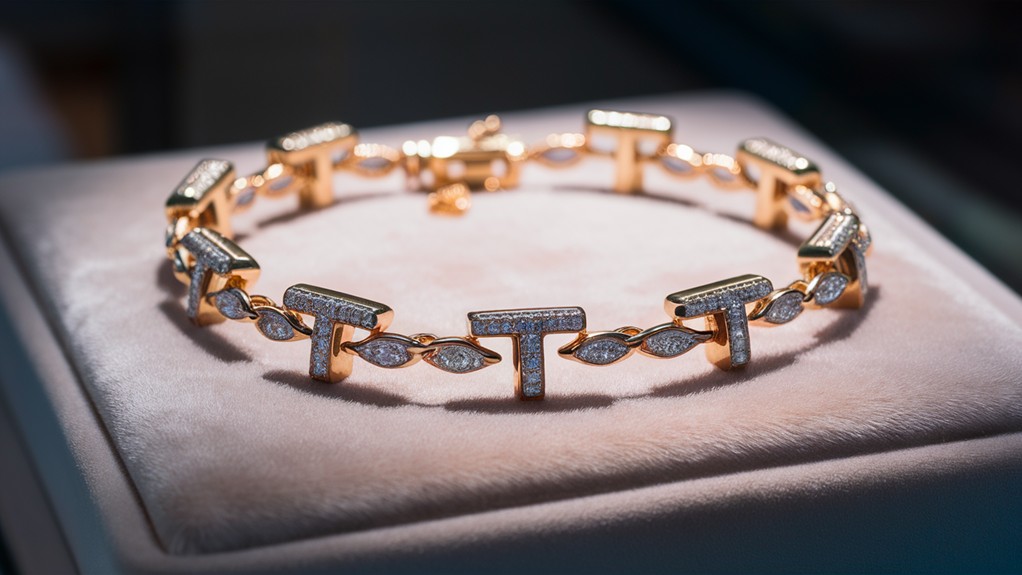As you consider investing in an emerald, you're likely wondering what drives its value. With prices reaching up to $10,000 per carat for high-quality stones, understanding the factors that impact its worth is crucial. You might assume it's just about the vibrant green color, but that's only the beginning. The country of origin, cut quality, and even treatments can greatly influence the emerald's value. And with global demand driving a 10% annual growth, you're probably curious to know what makes an emerald truly valuable – and what to look out for when making a purchase, since knowing this information is vital.
Our Highlighted Points
- Emerald price per carat can reach up to $10,000 for high-quality stones with vibrant green color and minimal inclusions.
- Colombian emeralds command a 20-30% premium due to their intense green color, making them the most valuable.
- The quality of the emerald's cut significantly impacts its value, with well-cut stones being more valuable.
- Minimal inclusions and a deeper green color increase the value per carat, making high-quality emeralds highly prized.
- The global demand for emeralds drives a 10% annual growth in value, making them a valuable investment opportunity.
Emerald Pricing Factors Explained

Determine the value of an emerald, and you'll quickly realize that it's not just about the carat weight.
In fact, the color of the emerald accounts for up to 70% of its value. Emeralds with a vibrant, saturated green color, known as "Colombian green," are considered the most valuable, with prices ranging from $10,000 to over $100,000 per carat.
Clarity further plays a significant role in emerald pricing, with inclusions affecting the stone's transparency and brilliance. Flawless emeralds are extremely rare and highly valuable.
The quality of the emerald's cut can likewise impact its value, as a well-cut stone can intensify its color and clarity, while a poorly cut stone can reduce its value by up to 50%.
Moreover, the country of origin is another crucial factor in emerald pricing, with Colombian emeralds being the most expensive owing to their intense green color.
When evaluating an emerald's price, consider these key factors: color, quality, inclusions, carat, and clarity to determine the Emerald Price.
Understanding Emerald Treatments
Your emerald's beauty may be more than meets the eye, as treatments can substantially impact its appearance and value.
In fact, approximately 99% of emeralds are treated with oil or resin to improve their clarity, making untreated emeralds extremely rare and highly valuable.
Treated emeralds, conversely, are markedly less expensive than natural emeralds, regardless of the natural emerald having more imperfections.
When it comes to emerald treatments, oil is a preferred choice since it may be restored over time, while resin treatments are more durable and difficult to remove without leaving residue.
High-viscosity, lab-grade cedar oil is a popular choice for oiling emeralds, and its use can greatly augment the appearance and value of the gemstone.
It's vital to note that treated emeralds require regular cleaning and re-oiling to keep them in good condition.
Avoid using ultrasonic cleaners on treated emeralds, as they can remove the oil and show the visible inclusions.
Understanding emerald treatments is vital in determining the value of your gemstone, and recognizing high clarity and minimal inclusions can markedly impact its price per carat.
Emerald Quality and Value Guide
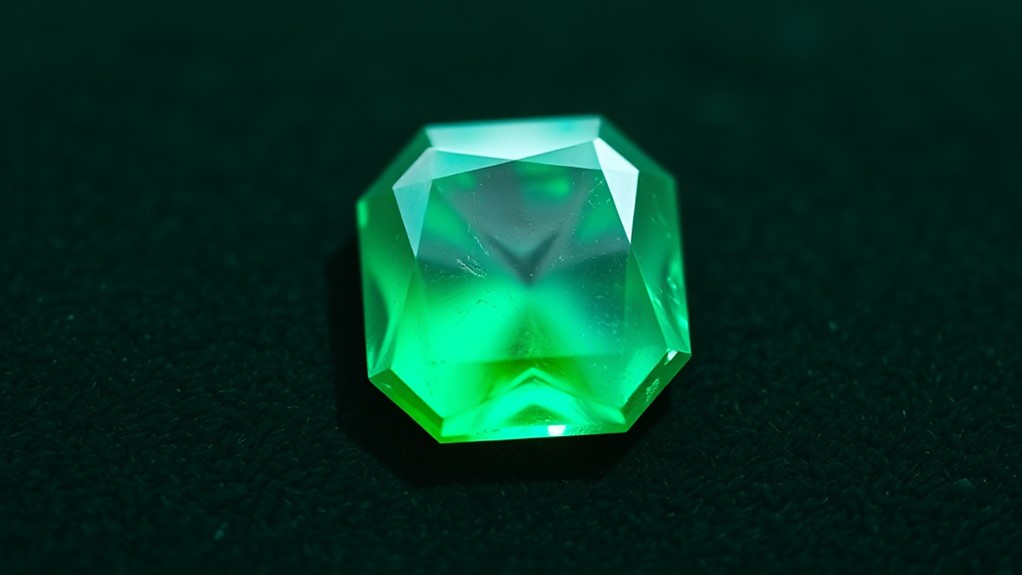
As you consider the factors that impact your emerald's value, it's clear that understanding treatments is just the beginning.
The quality and value of an emerald are influenced by several key factors, including its depth of color, clarity, and size.
The price of an emerald can vary greatly, ranging from $10 per carat to over $100,000 per carat, depending on these factors.
The value of an emerald increases exponentially with its size, with fine emeralds above 5 carats being exceptionally rare and costing between $90,000 and $150,000.
A slight variation in color and tone can substantially impact an emerald's value, with dull-colored emeralds being up to 40% cheaper than more vividly colored stones of the same size and shape.
The country of origin likewise plays a notable role, with Colombian emeralds being the most expensive owing to their intensely rich green color.
Color, Clarity, Cut, and Carat
Vibrancy is the lifeblood of an emerald, and it's the interplay of color, clarity, cut, and carat that brings this gemstone to life.
When evaluating an emerald, the color is the most vital factor, with a deep, vibrant green with slight blue or yellow undertones being highly sought-after.
Clarity, in contrast, is less significant, as most emeralds have inclusions. However, well-arranged inclusions can increase the price.
The cut of an emerald affects its clarity and arrangement of inclusions, with a well-cut emerald able to intensify its color and brightness.
Ultimately, the carat weight gauges the rarity of all these factors combined, with larger emeralds being more valuable owing to their greater rarity.
As you consider an emerald, keep in mind that the 4Cs work together to determine its price, with each factor influencing the others to produce a unique value.
Emerald Pricing Per Carat Breakdown
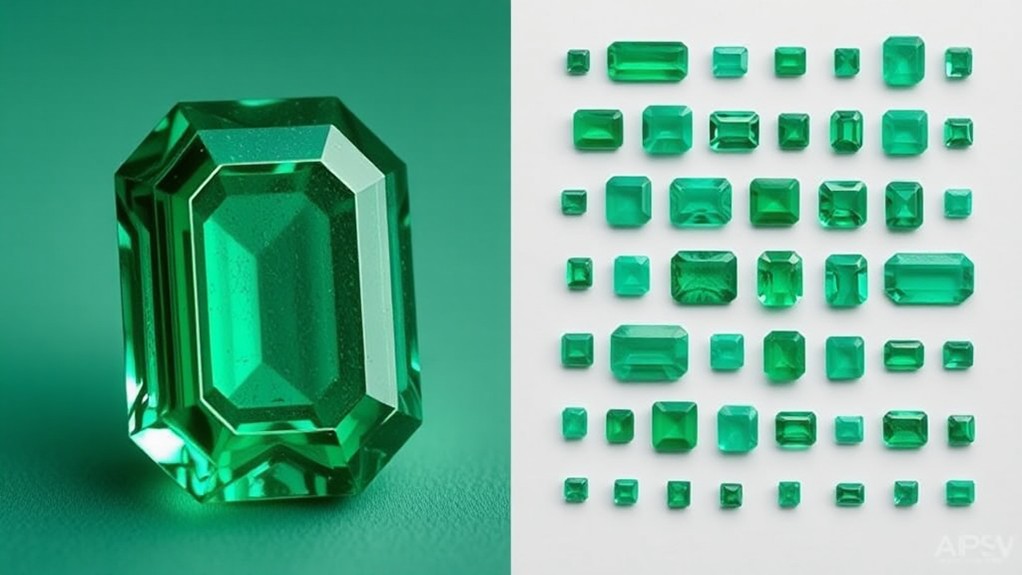
One key factor to ponder when evaluating an emerald's price is its cost per carat. This is due to the fact that emeralds' value is largely determined by their carat weight, with larger stones being rarer and more valuable.
In the realm of emeralds' price, you'll notice that it varies greatly depending on the quality of the gemstone. For example, a low-quality emerald with visible inclusions and a pale color may be much cheaper than a high-quality emerald with a deep, rich green color and no visible flaws. This is why it’s important to consider the emerald vs radiant cost comparison when shopping for gemstones. The cost difference between a lower-quality emerald and a higher-quality one can be significant, so it’s important to carefully evaluate the quality of the gemstone before making a purchase.
Low-quality emeralds with light color and many inclusions cost around $100-$500 per carat
Medium-quality emeralds with moderate color and some inclusions cost $500-$2,000 per carat
High-quality emeralds with vivid color and few inclusions can cost $2,000-$5,000+ per carat
As you can see, the price per carat increases dramatically as the quality of the emerald improves.
In fact, the highest quality emeralds with excellent color and clarity can cost tens of thousands of dollars per carat.
It's vital to understand that quality emeralds are rare, and their price reflects their scarcity.
Emerald Treatment Impact on Price
When evaluating an emerald's price, it's essential to weigh the treatment it has undergone, since approximately 99% of emeralds are treated with oil or resin to improve their clarity. This is pivotal in determining its value, as an emerald without treatment is exceptionally rare and highly valuable.
| Treatment Type | Impact on Price |
|---|---|
| Oil Treatment | Less expensive, but can be restored over time |
| Resin Treatment | More durable, but difficult to remove without residue |
| No Treatment | Highly valuable, commanding premiums despite inclusions |
| Low-Quality Oil Treatment | Decreases price, may be difficult to restore |
| High-Quality Oil Treatment | Increases price, can be easily restored |
A treated emerald's price is greatly less expensive than a natural emerald, regardless of the natural emerald having more flaws, owing to the rarity of natural emeralds. The premium customers will pay for natural emeralds is significant, with some high-quality natural emeralds costing tens of thousands of dollars per carat.
Caring for Your Emerald Jewelry
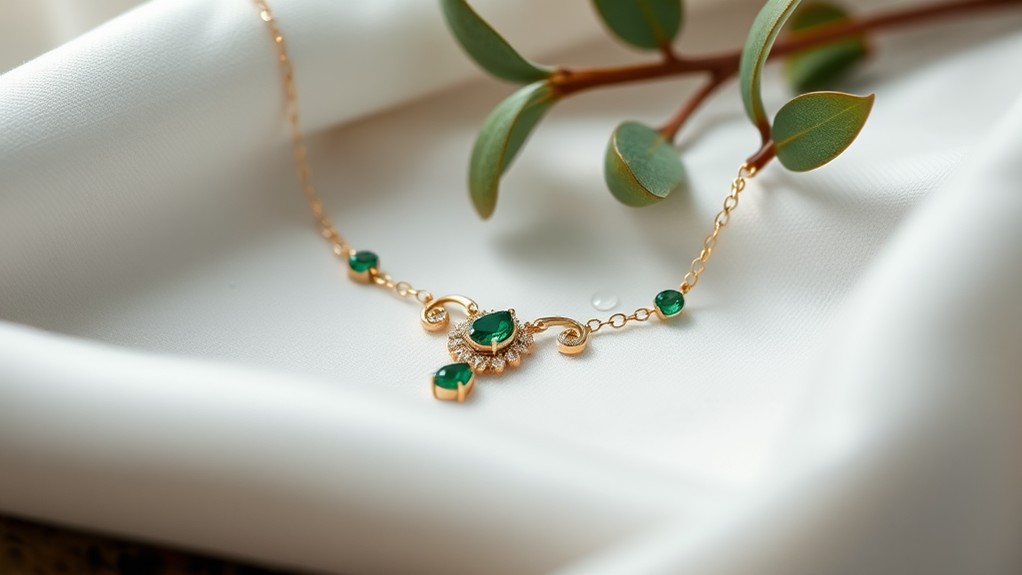
Caring for your emerald jewelry requires attention to detail and a gentle touch, as these precious stones are more delicate than they appear.
You'll need to avoid using ultrasonic cleaners on treated emeralds, as they can remove the oil and show the inclusions.
Regular cleaning and re-oiling are vital to keep treated emeralds in good condition, as the oil can evaporate over time, reducing the stone's clarity and beauty.
When cleaning your emerald, make sure to:
- Use a soft, dry cloth to wipe down the stone
- Mix a solution of warm water and mild dish soap for more thorough cleaning
- Avoid harsh chemicals or abrasive materials that can damage the stone
Remember to store your emerald jewelry separately from other pieces to prevent scratching or damage, and consider storing them in a cool, dry place to slow down the evaporation of the oil treatment.
By following these simple steps, you'll be able to enjoy your emerald jewelry for years to come.
Regular cleaning and re-oiling are crucial to keep treated emeralds in good condition, as the oil can evaporate over time, reducing the stone's clarity and beauty.
Emerald Market Value and Trends
As you admire your emerald jewelry, it's hard not to wonder about its value in the market. The emerald market value has been on the rise, with prices increasing by 15% annually over the last five years. This growth is driven by growing demand and limited supply of high-quality stones.
| Emerald Characteristic | Market Impact |
|---|---|
| Intense green color | Up to $10,000 per carat |
| Minimal inclusions | Up to $50,000 per carat for flawless emeralds above 2 carats |
| Colombian origin | 20-30% premium over other origins |
| Well-cut emerald | Higher value due to chromium and vanadium presence |
| Global demand | 10% annual growth expected over the next three years |
The cost of an emerald is heavily influenced by its origin, with Colombian emeralds commanding a premium. A well-cut emerald with intense green color and minimal inclusions can command a high price per carat. As the global emerald market continues to grow, it's crucial to stay informed about the trends and values to make informed purchasing decisions.
Gemstone Experts Evaluate Emeralds

You're likely curious about how gemstone experts evaluate emeralds, considering the significant impact it has on the stone's value.
When evaluating emeralds, experts come across a wide range of qualities that determine the stone's worth.
The most vital factor is the emerald's color, which can vary from a deep, vibrant green to slight variations like bluish or yellowish tones.
The clarity of an emerald plays a pivotal role, with fewer inclusions making the stone more valuable, and well-arranged inclusions increasing the price.
- Color: Emeralds are graded on a color scale, with the most valuable being those with a deep, vibrant green color and slight variations like bluish or yellowish tones.
- Clarity: The clarity of an emerald is pivotal, with fewer inclusions making the stone more valuable, and well-arranged inclusions increasing the price.
- Equipment and Partnerships: Gemstone experts use specialized equipment, such as magnifying glasses, microscopes, and spectroscopes, to evaluate the quality and authenticity of emeralds, and partnerships with reputable gem labs guarantee the accuracy of emerald evaluations.
Emerald Rarity and Investment Value
Now that you've got a better understanding of how gemstone experts evaluate emeralds, let's excavate what makes them a valuable investment opportunity.
As a rare gemstone, emeralds are highly valuable and sought after, with only 0.00001% of beryl mined being of gem quality. This rarity contributes to their high investment value, with high-quality stones appreciating in value over time, making them a popular choice for investors.
Colombian emeralds, in particular, are highly prized for their intense green color and are considered a solid investment opportunity, with prices increasing by up to 20% annually.
The value of emeralds is further driven by their limited supply, with new finds of high-quality emeralds being rare, and existing mines depleting their resources. Consequently, highly prized emeralds with minimal inclusions and vivid color can appreciate in value by up to 50% over a five-year period, making them a lucrative investment opportunity.
Frequently Asked Questions
Are Emeralds Increasing in Value?
You're wondering if emeralds are increasing in value? Yes, they are! With a 10-15% annual growth rate, high-quality emeralds are skyrocketing in value, driven by high demand and limited supply, making them a valuable investment opportunity.
What Is the Current Price of Emeralds?
You're wondering what the current price of emeralds is, and it's a great question! Depending on the grade, you can expect to pay anywhere from $10 to over $100,000 per carat, with high-quality ones costing upwards of $2,000 to $5,000+ per carat.
How Do I Know if My Emerald Is Valuable?
You determine your emerald's value by examining its color, clarity, country of origin, carat weight, and treatment. Look for a deep, vibrant green with slight variations, few inclusions, and a high-carat weight, and check if it's from Colombia or untreated.
Do Emeralds Hold Value?
You'll be happy to know that emeralds, especially high-quality ones, hold their value well over time and can even appreciate as a result of rarity and demand. In fact, high-grade emeralds can increase in value by 10-20% annually, making them a solid investment opportunity.
